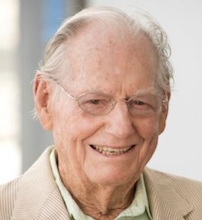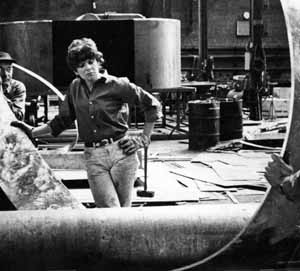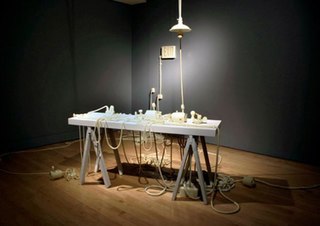
Morton Wayne Thiebaud was an American painter known for his colorful works depicting commonplace objects—pies, lipsticks, paint cans, ice cream cones, pastries, and hot dogs—as well as for his landscapes and figure paintings. Thiebaud is associated with the pop art movement because of his interest in objects of mass culture, although his early works, executed during the fifties and sixties, slightly predate the works of the classic pop artists. Thiebaud used heavy pigment and exaggerated colors to depict his subjects, and the well-defined shadows characteristic of advertisements were almost always included in his work.

The Buffalo AKG Art Museum, formerly known as the Albright–Knox Art Gallery, is an art museum in Buffalo, New York, United States, in Delaware Park. The museum was expanded beginning in 2021, and re-opened in June 2023.

Matthew Barney is an American contemporary artist and film director who works in the fields of sculpture, film, photography and drawing. His works explore connections among geography, biology, geology and mythology as well as notable themes of sex, intercourse, and conflict. His early pieces were sculptural installations combined with performance and video. Between 1994 and 2002, he created The Cremaster Cycle, a series of five films described by Jonathan Jones in The Guardian as "one of the most imaginative and brilliant achievements in the history of avant-garde cinema." He is also known for his projects Drawing Restraint 9 (2005), River of Fundament (2014) and Redoubt (2018).
Brian Alfred is an artist based in Brooklyn, New York.

Beverly Pepper was an American sculptor known for her monumental works, site specific and land art. She remained independent from any particular art movement. She lived in Italy, primarily in Todi, since the 1950s.
Isaac Soyer was a Russian-born American social realist painter and educator. His art work often portrayed working-class people of New York City in his paintings.

Kenneth Price was an American artist who predominantly created ceramic sculpture. He studied at the Chouinard Art Institute and Otis Art Institute in Los Angeles, before receiving his BFA degree from the University of Southern California in 1956. He continued his studies at Chouinard Art Institute in 1957 and received an MFA degree from New York State College of Ceramics at Alfred University in 1959. Kenneth Price studied ceramics with Peter Voulkos at Otis and was awarded a Tamarind Fellowship.
Leo Villareal is an American artist. His work combines LED lights and encoded computer programming to create illuminated displays. He is living and working in New York City.

Paul Feeley was an artist and director of the Art Department at Bennington College during the 1950s and early 1960s.
Fletcher C. Benton was an American sculptor and painter from San Francisco, California. Benton was widely known for his kinetic art as well as his large-scale steel abstract geometric sculptures.
David Reed is a contemporary American conceptual and visual artist.

Jeanne Silverthorne is an American sculptor, known for cast-rubber sculptures and installations that explore the artist's studio as a metaphor for artistic practice, the human body and psyche, and mortality. She gained prominence in New York City in the 1990s, as one of several material-focused sculptors who critiqued the austere, male-dominated Minimalist movement by embracing humble, unorthodox media and hand-made, personal and ephemeral qualities championed by artists such as Eva Hesse and Louise Bourgeois. She treats the studio as a physical and conceptual site to be excavated, documented and inventoried, examining in the words of Sculpture's Jan Riley "the end of studio arts … and the impossibility of this mode of expression regaining its former creative validity and vitality in today’s world." Art in America critic Raphael Rubinstein wrote that, like the late studio paintings of Philip Guston, Silverthorne examines "deeply melancholic realms, enlivened by the occasional mordant joke, in which lowly objects are relentlessly and lovingly queried for a meaning they never seem quite ready to yield."

Alan Saret is an American sculptor, draftsman, and installation artist, best known for his Postminimalism wire sculptures and drawings. He lives and works in Brooklyn.

Ree Morton was an American visual artist who was closely associated with the postminimalist and feminist art movements of the 1970s.
Philip Pavia (1911-2005) was a culturally influential American artist of Italian descent, known for his scatter sculpture and figurative abstractions, and the debate he fostered among many of the 20th century's most important art thinkers. A founder of the New York School of Abstract Expressionism, he "did much to shift the epicenter of Modernism from Paris to New York," both as founding organizer of The Club and as founder, editor and publisher of the short-lived but influential art journal It Is: A Magazine for Abstract Art. Reference to the magazine appears in the archives of more than two dozen celebrated art figures, including Picasso, Peggy Guggenheim, and art critic Clement Greenberg. The Club is credited with inspiring art critic Harold Rosenberg’s influential essay “The American Action Painters" and the historic 9th Street Show.

Tobi Kahn is an American painter and sculptor. Kahn lives and works in New York City and is on the faculty at the School of Visual Arts.
Terry Rosenberg is an American artist, known for painting, sculpture, and drawings that reference the body.
Kevin Beasley is an American artist working in sculpture, performance art, and sound installation. He lives and works in New York City. Beasley was included in the Whitney Museum of American Art's Biennial in 2014 and MoMA PS1's Greater New York exhibition in 2015.
Vincent DaCosta Smith was an American artist, painter, printmaker and teacher. He was known for his depictions of black life.
Ahron Ben-Shmuel, also known as Ben Shmuel, Aaron Ben Shmuel (1903–1984) was an American artist, known for his direct carvered stone sculptures, figural granite work and paintings. He worked for the Works Progress Administration (WPA), and he was associated with left-wing politics despite his art having no clear political references.










